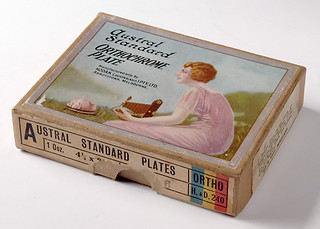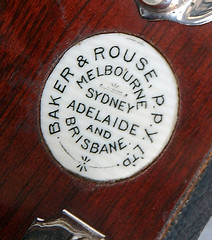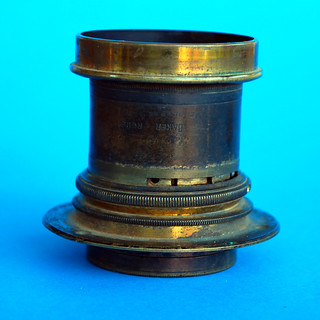Difference between revisions of "Baker and Rouse"
(Added text and reference) |
Hanskerensky (talk | contribs) m (→Links: Redirected Link URL to new site) |
||
| (14 intermediate revisions by 4 users not shown) | |||
| Line 1: | Line 1: | ||
{{stub}} | {{stub}} | ||
| − | '''Baker and Rouse''' was a maker of photographic materials in Melbourne, Australia, from the late 19th century well into the 20th. '''Thomas Baker''' started the company as the '''Austral Plate Company''' in 1884. He formed a partnership with '''John Rouse''' in 1887; the company was renamed '''Thomas Baker and Company Laboratory''', then '''Baker and Rouse Australia Laboratory''', and finally in 1896 '''Baker and Rouse Pty Ltd.'''<ref>Introductory page to the [ | + | '''Baker and Rouse''' was a maker of photographic materials in Melbourne, Australia, from the late 19th century well into the 20th. '''Thomas Baker''' started the company as the '''Austral Plate Company''' in 1884. He formed a partnership with '''John Rouse''' in 1887; the company was renamed '''Thomas Baker and Company Laboratory''', then '''Baker and Rouse Australia Laboratory''', and finally in 1896 '''Baker and Rouse Pty Ltd.'''<ref>Introductory page to the [https://museumsvictoria.com.au/kodak/history/baker-rouse/ Baker & Rouse collection] at [https://museumsvictoria.com.au/ Museums Victoria].</ref> In the 1890s the company had stores in Melbourne and Adelaide<ref>See inscription on this [https://www.flickr.com/photos/heritagefutures/4284276943 6 x 5 Rapid Symmetrical] and this [https://www.flickr.com/photos/heritagefutures/sets/72157647098625653 Anastigmat Series III].</ref> and later also in Sydney and Brisbane.<ref>See inscription on this [https://www.flickr.com/photos/heritagefutures/10205343885 Wide Angle Rectilinear 4 ¼ X 3 ¼].</ref> In April 1905 Baker & Rouse took over the sole agency for Kodak materials in Australia.<ref>Sandy Barrie "Australians Behind the Camera" (2002; ISBN <nowiki>0 9587883 8 3</nowiki>) p.11.</ref> Baker and Rouse merged with [[Kodak|Eastman Kodak]] in 1908, both men remaining as directors of [[Kodak's international plants|Kodak (Australasia) Pty. Ltd.]] |
| Line 8: | Line 8: | ||
|image_align= left | |image_align= left | ||
|image_text= Austral Plates (made by Kodak Australasia) | |image_text= Austral Plates (made by Kodak Australasia) | ||
| + | |image_by= Geoff Harrisson | ||
| + | |image_rights= wp | ||
| + | }} | ||
| + | |||
| + | {{Flickr_image | ||
| + | |image_source= http://www.flickr.com/photos/90900361@N08/16141654711/in/pool-camerawiki | ||
| + | |image= http://farm8.staticflickr.com/7487/16141654711_9284edbb16_m.jpg | ||
| + | |image_align= left | ||
| + | |image_text= Label c.1902 | ||
|image_by= Geoff Harrisson | |image_by= Geoff Harrisson | ||
|image_rights= wp | |image_rights= wp | ||
| Line 25: | Line 34: | ||
==Lenses== | ==Lenses== | ||
| − | Baker Rouse imported lenses from European manufacturers, including French.<ref>See inscription on this [https://www.flickr.com/photos/heritagefutures/10205343885 Wide Angle Rectilinear 4 ¼ X 3 ¼].</ref> | + | Baker & Rouse imported lenses from European manufacturers, including French.<ref>See inscription on this [https://www.flickr.com/photos/heritagefutures/10205343885 Wide Angle Rectilinear 4 ¼ X 3 ¼].</ref> |
| − | *6 x 5 Rapid Symmetrical <ref>See this [https://www.flickr.com/photos/heritagefutures/4284276943 lens].</ref> | + | *6 x 5 Rapid Symmetrical <ref>See this [https://www.flickr.com/photos/heritagefutures/4284276943 lens] (Photographica Collection Dirk Spennemann).</ref> |
French Origin | French Origin | ||
| + | * Anastigmat Series III<ref>See this [https://www.flickr.com/photos/heritagefutures/sets/72157647098625653 lens] (Photographica Collection Dirk Spennemann).</ref> | ||
* Wide Angle Rectilinear 4 ¼ X 3 ¼ <ref>See inscription on this [https://www.flickr.com/photos/heritagefutures/10205343885 lens].</ref> | * Wide Angle Rectilinear 4 ¼ X 3 ¼ <ref>See inscription on this [https://www.flickr.com/photos/heritagefutures/10205343885 lens].</ref> | ||
| Line 35: | Line 45: | ||
==Links== | ==Links== | ||
| − | * [https://www.flickr.com/photos/60141386@N08/5487960787 Austral No. 3A] falling-plate camera marked for Baker & Rouse Pty Ltd, presumably dating it to 1908 or earlier, in [https://www.flickr.com/photos/60141386@N08/ | + | * [https://www.flickr.com/photos/60141386@N08/5487960787 Austral No. 3A] falling-plate camera marked for Baker & Rouse Pty Ltd, presumably dating it to 1908 or earlier, in [https://www.flickr.com/photos/60141386@N08/ sesquiped]'s Flickr photostream. |
| − | * [ | + | * [https://museumsvictoria.com.au/kodak/history/baker-rouse/ Baker and Rouse history] at [https://museumsvictoria.com.au Museums Victoria collections] |
* [https://www.flickr.com/photos/heritagefutures/sets/72157636425223173 Wide Angle Rectilinear 4 ¼ X 3 ¼] images with [[Nikon]] D800 ([[Antique Camera Simulator]]) | * [https://www.flickr.com/photos/heritagefutures/sets/72157636425223173 Wide Angle Rectilinear 4 ¼ X 3 ¼] images with [[Nikon]] D800 ([[Antique Camera Simulator]]) | ||
| + | * Patents by Thomas Baker, at [http://worldwide.espacenet.com/advancedSearch?locale=en_EP Espacenet], the patent search facility of the European Patent Office. | ||
| + | ** [http://worldwide.espacenet.com/publicationDetails/originalDocument?CC=GB&NR=190224019A&KC=A&FT=D&ND=3&date=19030122&DB=EPODOC&locale=en_EP British Patent 24019], ''Improvements in or relating to the preparation of photographic prints for toning'', filed November 1902 and granted January 1903 to Thomas Baker of Baker & Rouse Proprietary Ltd. The patent describes a method to avoid washing prints before toning them, when using printing-out paper. It was usual to wash such prints for a long time, to eliminate soluble silver compounds which would affect the toning. Baker noted that this long washing was inconvenient, and could damage the print, especially in warm weather. He stated that immersion in a suitable solution of sodium chloride for as little as a minute would convert the soluble silver salts to insoluble ones, and gave a recipe for a suitable bath. He further stated that addition of iodide and bromide to the bath in small amounts improved the result of the toning. | ||
| + | ** [http://worldwide.espacenet.com/publicationDetails/originalDocument?CC=US&NR=1269365A&KC=A&FT=D&ND=3&date=19180611&DB=EPODOC&locale=en_EP US Patent 1269365], ''Photographic roll-film cartridge'', filed December 1916 and granted June 1918 to Thomas Baker, by then of Eastman Kodak. The patent describes an improvement to a roll-film cartridge (described as an [[Autographic]] one, though this detail does not matter). As in a modern 120 roll, the leading end of the film is attached to the backing paper by a gummed sticker or tape. The trailing end is not fixed, because it must be allowed to 'creep' slightly relative to the backing during rolling. However, it was normal for the trailing end to be fixed to the paper for development, and a gummed sticker was provided for this. The sticker was attached to the film, and the patent states that the moisture used to wet the gum could migrate, causing the sticker to adhere to the backing paper prematurely. Baker's patent solves this simply by making the sticker long, with an ungummed section in the middle. | ||
[[Category:Camera makers]] | [[Category:Camera makers]] | ||
[[Category:Film makers]] | [[Category:Film makers]] | ||
[[Category:Australia]] | [[Category:Australia]] | ||
Latest revision as of 04:35, 6 July 2023
Baker and Rouse was a maker of photographic materials in Melbourne, Australia, from the late 19th century well into the 20th. Thomas Baker started the company as the Austral Plate Company in 1884. He formed a partnership with John Rouse in 1887; the company was renamed Thomas Baker and Company Laboratory, then Baker and Rouse Australia Laboratory, and finally in 1896 Baker and Rouse Pty Ltd.[1] In the 1890s the company had stores in Melbourne and Adelaide[2] and later also in Sydney and Brisbane.[3] In April 1905 Baker & Rouse took over the sole agency for Kodak materials in Australia.[4] Baker and Rouse merged with Eastman Kodak in 1908, both men remaining as directors of Kodak (Australasia) Pty. Ltd.

|
| Austral Plates (made by Kodak Australasia) image by Geoff Harrisson (Image rights) |

|
| Label c.1902 image by Geoff Harrisson (Image rights) |

|
| Baker & Rouse 6 x 5 Rapid Symmetrical image by Dirk HR Spennemann (Image rights) |
Cameras
Austral falling-plate detective cameras have been seen in several sizes (No. 1A, No. 3 and No. 3A are listed at various websites)
Lenses
Baker & Rouse imported lenses from European manufacturers, including French.[5]
- 6 x 5 Rapid Symmetrical [6]
French Origin
Notes
- ↑ Introductory page to the Baker & Rouse collection at Museums Victoria.
- ↑ See inscription on this 6 x 5 Rapid Symmetrical and this Anastigmat Series III.
- ↑ See inscription on this Wide Angle Rectilinear 4 ¼ X 3 ¼.
- ↑ Sandy Barrie "Australians Behind the Camera" (2002; ISBN 0 9587883 8 3) p.11.
- ↑ See inscription on this Wide Angle Rectilinear 4 ¼ X 3 ¼.
- ↑ See this lens (Photographica Collection Dirk Spennemann).
- ↑ See this lens (Photographica Collection Dirk Spennemann).
- ↑ See inscription on this lens.
Links
- Austral No. 3A falling-plate camera marked for Baker & Rouse Pty Ltd, presumably dating it to 1908 or earlier, in sesquiped's Flickr photostream.
- Baker and Rouse history at Museums Victoria collections
- Wide Angle Rectilinear 4 ¼ X 3 ¼ images with Nikon D800 (Antique Camera Simulator)
- Patents by Thomas Baker, at Espacenet, the patent search facility of the European Patent Office.
- British Patent 24019, Improvements in or relating to the preparation of photographic prints for toning, filed November 1902 and granted January 1903 to Thomas Baker of Baker & Rouse Proprietary Ltd. The patent describes a method to avoid washing prints before toning them, when using printing-out paper. It was usual to wash such prints for a long time, to eliminate soluble silver compounds which would affect the toning. Baker noted that this long washing was inconvenient, and could damage the print, especially in warm weather. He stated that immersion in a suitable solution of sodium chloride for as little as a minute would convert the soluble silver salts to insoluble ones, and gave a recipe for a suitable bath. He further stated that addition of iodide and bromide to the bath in small amounts improved the result of the toning.
- US Patent 1269365, Photographic roll-film cartridge, filed December 1916 and granted June 1918 to Thomas Baker, by then of Eastman Kodak. The patent describes an improvement to a roll-film cartridge (described as an Autographic one, though this detail does not matter). As in a modern 120 roll, the leading end of the film is attached to the backing paper by a gummed sticker or tape. The trailing end is not fixed, because it must be allowed to 'creep' slightly relative to the backing during rolling. However, it was normal for the trailing end to be fixed to the paper for development, and a gummed sticker was provided for this. The sticker was attached to the film, and the patent states that the moisture used to wet the gum could migrate, causing the sticker to adhere to the backing paper prematurely. Baker's patent solves this simply by making the sticker long, with an ungummed section in the middle.